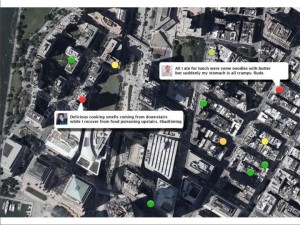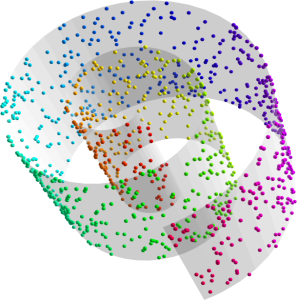Computer science researchers from the University of Rochester have developed an app for health departments that uses natural language processing and artificial intelligence to identify food poisoning-related tweets, connect them to restaurants using geotagging and identify likely hot spots.
 The team presented the results of its research at the 30th Association for the Advancement of Artificial Intelligence (AAAI) conference in Phoenix, Arizona, in February. The project was supported by grants from the National Science Foundation, the National Institutes of Health and the Intel Science and Technology Center for Pervasive Computing.
The team presented the results of its research at the 30th Association for the Advancement of Artificial Intelligence (AAAI) conference in Phoenix, Arizona, in February. The project was supported by grants from the National Science Foundation, the National Institutes of Health and the Intel Science and Technology Center for Pervasive Computing.
Location-based epidemiology is nothing new. John Snow, credited as the world’s first epidemiologist, used maps of London in 1666 to identify the source of the Cholera epidemic that was rampaging the city (a neighborhood well) and in the process discovered the connection between the disease and water sources.
However, as the researchers showed, it’s now possible to deduce the source of outbreaks using publicly available social media content and deep learning algorithms trained to recognize the linguistic traits associated with a disease – “I feel nauseous,” for instance.
“We don’t need to go door to door like John Snow did,” says Adam Sadilek, a researcher who worked on the project at the University of Rochester and who is now at Google Research. “We can use all this data and mine it automatically.”
The work presented at AAAI described a recent collaboration with the Las Vegas health department, where officials used the app they developed, called nEmesis, to improve the city’s inspection protocols.
Typically, cities (including Las Vegas) use a random system to decide which restaurants to inspect on any given day. The research team convinced Las Vegas officials to replace their random system with a list of possible sites of infection derived using their smart algorithms.
In a controlled experiment, half of the inspections were performed using the random approach and half were done using nEmesis, without the inspectors knowing that any change had occurred in the system.
 “Each morning we gave the city a list of places where we knew that something was wrong so they could do an inspection of those restaurants,” Sadilek said.
“Each morning we gave the city a list of places where we knew that something was wrong so they could do an inspection of those restaurants,” Sadilek said.
For three months, the system automatically scanned an average of 16,000 tweets from 3,600 users each day. 1,000 of those tweets snapped to a specific restaurant and of those, approximately 12 contained content that likely signified food poisoning. They used these tweets to generate a list of highest-priority locations for inspections.
Analyzing the results of the experiment, they found the tweet-based system led to citations for health violations in 15 percent of inspections, compared to 9 percent using the random system. Some of the inspections led to warnings; others resulted in closures.
The researchers estimate that these improvements to the efficacy of the inspections led to 9,000 fewer food poisoning incidents and 557 fewer hospitalization in Las Vegas during the course of the study.
